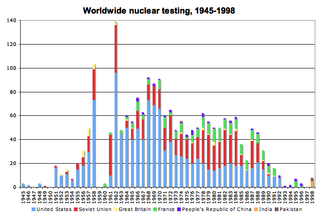Related Research Articles

Nuclear disarmament is the act of reducing or eliminating nuclear weapons. Its end state can also be a nuclear-weapons-free world, in which nuclear weapons are completely eliminated. The term denuclearization is also used to describe the process leading to complete nuclear disarmament.
The War Resisters League (WRL) is the oldest secular pacifist organization in the United States, having been founded in 1923.
Peace Action is a peace organization whose focus is on preventing the deployment of nuclear weapons in space, thwarting weapons sales to countries with human rights violations, and promoting a new United States foreign policy based on common security and peaceful resolution to international conflicts.

The World Peace Council (WPC) is an international organization created in 1949 by the Cominform and propped up by the Soviet Union. Throughout the Cold War, WPC engaged in propaganda efforts on behalf of the Soviet Union, whereby it criticized the United States and its allies while defending the Soviet Union's involvement in numerous conflicts.

Opposition to United States involvement in the Vietnam War began in 1965 with demonstrations against the escalating role of the United States in the war. Over the next several years, these demonstrations grew into a social movement which was incorporated into the broader counterculture of the 1960s.

The Women's International League for Peace and Freedom (WILPF) is a non-profit non-governmental organization working "to bring together women of different political views and philosophical and religious backgrounds determined to study and make known the causes of war and work for a permanent peace" and to unite women worldwide who oppose oppression and exploitation. WILPF has national sections in 37 countries.

Veterans for Peace is an organization founded in 1985. Initially made up of US military veterans of World War II, the Korean War and the Vietnam War - later including veterans of the Gulf War, the War in Afghanistan and the Iraq War - as well as peacetime veterans and non-veterans, it has since spread overseas and has an active offshoot in the United Kingdom. The group works to promote alternatives to war.

The International Peace Bureau, founded in 1891, is one of the world's oldest international peace federations. The organisation was awarded the Nobel Peace Prize in 1910 for acting "as a link between the peace societies of the various countries". In 1913, Henri La Fontaine was also awarded the Prize "[For his work as] head of the International Peace Bureau". As of 2012, eleven other Nobel Peace Prize laureates have been members of the IPB.

Women Strike for Peace was a women's peace activist group in the United States. Nearing the height of the Cold War in 1961, about 50,000 women marched in 60 cities around the United States to demonstrate against the testing of nuclear weapons. It was the largest national women's peace protest during the 20th century. Another group action was led by Dagmar Wilson, with about 1,500 women gathering at the foot of the Washington Monument while President John F. Kennedy watched from the White House. The protest helped push the United States and the Soviet Union into signing a nuclear test-ban treaty two years later. Reflecting the era in which the group's leaders had been raised, between the First-wave feminism and the Second-wave feminism movements, their actions and pleas leaned towards female self-sacrifice rather than towards their own self-interests. However, they pushed the power of a concerned mother to the forefront of American politics, transforming the mother from a "passive victim of war to active fighter for peace".
Feminism is a broad term given to works of those scholars who have sought to bring gender concerns into the academic study of international politics and who have used feminist theory and sometimes queer theory to better understand global politics and international relations as a whole.
Anti-nuclear organizations may oppose uranium mining, nuclear power, and/or nuclear weapons. Anti-nuclear groups have undertaken public protests and acts of civil disobedience which have included occupations of nuclear plant sites. Some of the most influential groups in the anti-nuclear movement have had members who were elite scientists, including several Nobel Laureates and many nuclear physicists.

A peace movement is a social movement which seeks to achieve ideals such as the ending of a particular war or minimizing inter-human violence in a particular place or situation. They are often linked to the goal of achieving world peace. Some of the methods used to achieve these goals include advocacy of pacifism, nonviolent resistance, diplomacy, boycotts, peace camps, ethical consumerism, supporting anti-war political candidates, supporting legislation to remove profits from government contracts to the military–industrial complex, banning guns, creating tools for open government and transparency, direct democracy, supporting whistleblowers who expose war crimes or conspiracies to create wars, demonstrations, and political lobbying. The political cooperative is an example of an organization which seeks to merge all peace-movement and green organizations; they may have diverse goals, but have the common ideal of peace and humane sustainability. A concern of some peace activists is the challenge of attaining peace when those against peace often use violence as their means of communication and empowerment.
The Nova Scotia Voice of Women for Peace (NSVOW) is an active branch of the Canadian Voice of Women for Peace (VOW). Established in 1960, VOW is a local, national and international feminist Non Governmental Organization (NGO) composed of diverse women with consultative status at the United Nations Economic & Social Council (ECOSOC). For almost 50 years, VOW has advocated for a world without war. The organization's mandate is to "provide a means for women to promote world peace and justice, through education of themselves and others to take an equal part in the democratic process of decision making; and to cooperate with women throughout the world to create the mutual respect and understanding necessary for the peaceful resolution of international conflict."

The application of nuclear technology, both as a source of energy and as an instrument of war, has been controversial.

The Women's International Democratic Federation (WIDF) is an international women's rights organization. Established in 1945, it was most active during the Cold War when, according to historian Francisca de Haan, it was "the largest and probably most influential international women's organization of the post-1945 era". Following the dissolution of the Soviet Union in 1991, its headquarters were moved from Berlin to Paris. In 2002, with the election of Márcia Campos as president, the office relocated to Brasília. Subsequently, in 2007 the WIDF secretariat was located in São Paulo. Since 2016, the president has been Lorena Peña of El Salvador and the world headquarters has been located in San Salvador. The WIDF's magazine, Women of the Whole World, was published in six languages: Arabic, English, French, German, Russian, and Spanish.

An anti-war movement is a social movement, usually in opposition to a particular nation's decision to start or carry on an armed conflict. The term anti-war can also refer to pacifism, which is the opposition to all use of military force during conflicts, or to anti-war books, paintings, and other works of art. Some activists distinguish between anti-war movements and peace movements. Anti-war activists work through protest and other grassroots means to attempt to pressure a government to put an end to a particular war or conflict or to prevent one from arising.
The Vancouver Indochinese Women's Conference (VICWC) took place in April 1971, where close to a thousand women from Canada and the United States met with Indochinese women in Vancouver, British Columbia, Canada in a protest of the Vietnam War organized by the Voice of Women. There was also a sister conference in Toronto, held from April 9 to 11, 1971. These women came from various backgrounds and cultures; black Chicana/Latina, white, and Indochinese women all participated. This conference was a spinoff from an earlier and smaller Indochinese feminist conference which was held in 1967 to give voice to marginalized women.

In international law, Nuclear Weapons Free Zones are areas in which a group of states has prohibited the presence of nuclear weapons, according to criteria set and recognized by the United Nations. On the international level, Canada is not a part of any Nuclear Weapon Free Zone as defined by the United Nations. Canada is a signatory of the Treaty on the Non-Proliferation on Nuclear Weapons, a statute that has similar aims to those of NWFZs and even encourages the establishment of multinational NWFZs, but is not directly comparable. However, certain areas within Canada have voluntarily designated themselves as Nuclear Free Zones (NFZs) or Nuclear Weapons Free Zones (NWFZs). Generally, these nuclear weapons free zones and nuclear free zones are codified within Municipal and Provincial jurisdictions.
References
- ↑ Staff writer (2024). "Canadian Voice of Women for Peace (VOW)". UIA Global Civil Society Database. uia.org. Brussels, Belgium: Union of International Associations. Yearbook of International Organizations Online. Retrieved December 24, 2024.
- 1 2 3 4 5 "About Us – Canadian Voice of Women for Peace" . Retrieved April 12, 2012.
- 1 2 3 4 5 6 7 8 9 10 11 12 13 Early, Frances (2009). "Re-imaging War: The Voice of Women, the Canadian Aid for Vietnamese Children, 1966–1976". Peace and Change: A Journal of Peace Research . 34 (2): 148–163.
- 1 2 3 4 5 6 7 "Vow Herstory". vowpeace.org. Archived from the original on November 21, 2021. Retrieved November 19, 2021.
- 1 2 Hagan, John (2001). "Cause and Country: The Politics of Ambivalence and the American Vietnam War Resistance in Canada". Social Problems . 48 (2): 168–184.
- 1 2 Brookfield, Tarah (2012). Cold War Comforts: Canadian Women, Child Safety, and Global Insecurity, 1945–1975. Wilfrid Laurier University Press. pp. 1–20.
- 1 2 3 4 5 Grady, Sylvia. "Voice of Women (VOW) – Rise Up! Feminist Digital Archive". riseupfeministarchive.ca. Archived from the original on April 11, 2018. Retrieved November 21, 2021.
- ↑ "Women's Education Des Femmes – Spring −1994 -Vol. 11 – No.1 – Page – 57". en.copian.ca. Retrieved March 23, 2022.
- 1 2 Prentice, Alison (1998). Canadian Women: A History. Toronto: Harcourt Brace.
- 1 2 3 4 5 6 7 Macpherson, Kay, and Tabitha Marshall. "Canadian Voice of Women for Peace | The Canadian Encyclopedia". www.thecanadianencyclopedia.ca. Archived from the original on March 19, 2015. Retrieved November 21, 2021.
- ↑ "Peace Magazine Archive – Voice of Women for Peace" . Retrieved April 12, 2012.
- 1 2 3 4 Alton, Janis (2002). "We've Come a Long Way: Engendering Peace-building and the New Diplomacy (Voice of Women for Peace)". Canadian Women Studies . 22 (22): 72.